

Learning Matters: Past ways of learning should not be forgotten. "What was considered a good education 50 years ago… is no longer enough for success in college, career and citizenship in the 21st Century.

" That's the introduction to the National Education Assn.'s report on the Partnership for 21st Century Skills ( and it's been the message of many a school board meeting and education conference over the last 10 years. Fast-paced "change happens" videos with pulsing soundtracks have played to audiences locally and across the state to jar them out of their old 20th-century worlds and into the new. Technology in classrooms is commonplace. With online attendance reporting and homework hotlines, computer-based testing, student-produced digital media and even three-dimensional printing, schools are incorporating technology as our district motto suggests, "To prepare our children for their future. " Yes, the cultural landscape has altered, and schools must certainly change with it.
Pin by Lesson Planet on Quotes for Teachers. Bloom's taxonomy. Top-Tens-of-Employee-Engagement.pdf. What You Need To Know About Training Your Employees So They'll Stick Around. Employee development is a critical issue for any business: People don’t just stay as they were when you found them--they change and develop over time.
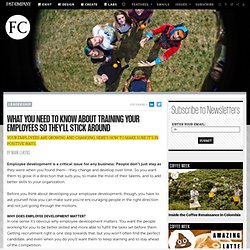
So you want them to grow in a direction that suits you, to make the most of their talents, and to add better skills to your organization. Before you think about developing your employee development, though, you have to ask yourself how you can make sure you’re encouraging people in the right direction and not just going through the motions. Why does employee development matter? In one sense it’s obvious why employee development matters.
You want the people working for you to be better skilled and more able to fulfill the tasks set before them. Blended learning. The Best Research Demonstrating That Lectures Are Not The Best Instructional Strategy. There has been a fair amount of recent research documenting the ineffectiveness of lectures as an instructional strategy.

I thought I’d bring articles about the research together in one place. You might also be interested in The Best Posts Questioning If Direct Instruction Is “Clearly Superior.” Let me know what I’m missing here: A study was just announced a couple of years ago claiming — surprise, surprise — that integrating pair work and small groups in teaching is more effective than straight lectures. Science Daily reported it in an article titled Interactive Teaching Methods Double Learning in Undergraduate Physics Class. 4 Essential Rules Of 21st Century Learning. 4 Essential Rules Of 21st Century Learning by Jennifer Rita Nichols The term “21st century” has become an integral part of educational thinking and planning for the future.
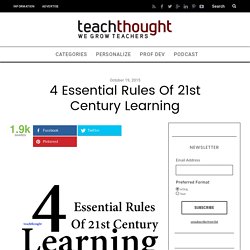
Eight Ways of Looking at Intelligence. Big Ideas In “Thirteen Ways of Looking At A Blackbird,” poet Wallace Stevens takes something familiar—an ordinary black bird—and by looking at it from many different perspectives, makes us think about it in new ways.
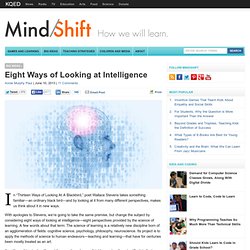
With apologies to Stevens, we’re going to take the same premise, but change the subject by considering eight ways of looking at intelligence—eight perspectives provided by the science of learning. A few words about that term: The science of learning is a relatively new discipline born of an agglomeration of fields: cognitive science, psychology, philosophy, neuroscience.
3 Knowledge Domains For The 21st Century Student. Thinking in the 21st century is just different.
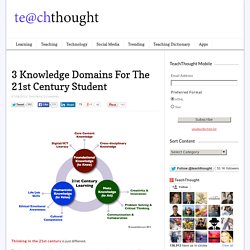
That doesn’t mean we’re all suddenly omnipotent cyborgs, nor does it mean we’ve all become mindless social media addicts that spend our cognitive might tapping, swiping, and drooling on our smartphone and tablet screens. But just as the 19th century presented unique challenges to information processing than the 18th or 20th, the 21st century is different than the one before, or that the one that will come after. Ten Reasons People Resist Change - Rosabeth Moss Kanter.
By Rosabeth Moss Kanter | 12:00 PM September 25, 2012.

Making Learning Relevant. CC licensed image shared by Flickr user Steve Heath What is the purpose of K-12 schooling?
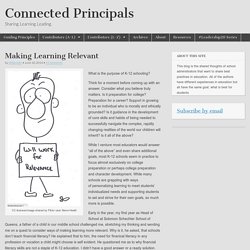
Think for a moment before coming up with an answer. Consider what you believe truly matters. Is it preparation for college? Preparation for a career? The Importance Of Mobile Learning In (And Out Of) The Classroom. There has always been at least some sort of disconnect between how things are taught in a classroom and how things work in the ‘real world’.
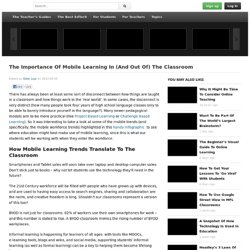
In some cases, the disconnect is very distinct (how many people took four years of high school language classes only to be able to barely introduce yourself in the language?). Many newer pedagogical models aim to be more practical (like Project Based Learning or Challenge Based Learning ). So it was interesting to take a look at some of the mobile trends (and specifically, the mobile workforce trends) highlighted in this handy infographic to see where education might best make use of mobile learning, since this is what our students will be working with when they enter the workforce.
Transform Training: Harness the New Tools for Training to Develop the Best Talent. Over the next five years, how you train and educate your staff won’t just change; it’ll transform.

What’s the difference? Changing means continuing to do essentially the same thing, only introducing some variation in degree. Transformation means doing something utterly and radically different. For example, moving our music from cassette tape to CD changed how you listen to music. Mobile Learning: Transforming Education, Engaging Students, and Improving Outcomes. Education in the United States Education is at a critical juncture in the United States. It is vital for workforce development and economic prosperity, yet is in need of serious reform. Video Game Creators Are Using Apps To Teach Empathy : All Tech Considered. Hide captionA screenshot of the iPad game If, which aims to teach kids how to navigate interpersonal challenges and failures. A screenshot of the iPad game If, which aims to teach kids how to navigate interpersonal challenges and failures. Much of the modern education reform movement has centered around the drive for data.
Standardized tests now gauge whether children are at grade level seemingly every few months. Kids are observed, measured and sorted almost constantly. In Silicon Valley, a $20 billion industry does much the same thing — but for a different purpose. How to promote lifelong learning using technology. Gerry Griffin tells the community why mobile could be the solution to a successful lifelong learning strategy. The demands of today’s ever-changing workplace have led to a growing focus on continuous and self-motivated learning. Technology can enable staff to happily and readily pick up new knowledge and skills. The first half of this article looks at how and why technology is so well placed to be the key to open the door to lifelong learning.
The second half examines how people management professionals can use technology to foster such a learning culture. Mind the gap First, with traditional training, there is a gap in time and space between when you learned and where/when you applied that learning. Through this gap, a lot of valuable knowledge and skills escape. Many employees are no longer geographically bound, both a major challenge and opportunity in today’s workplace.
An online edition of the Waterbury Record newspaper: Weekly Editorial. Twenty-first century learning requires a shift in the mental model of the American education system. The current model is equivalent to the beliefs, attitudes and behaviors that have been shaped by 150 years of stories, assumptions and practices in American education. It encompasses the entire scope of education, from the building to the bell schedule, curriculum to instruction, unions to boards, and local control to federal mandates. An online edition of the Waterbury Record newspaper: Weekly Editorial. What did Einstein know about Knowledge Management? Quite a lot, it appears! Here are my top ten favourite “Einstein on KM” quotes, which I have roughly curated into a journey from information to knowledge, through to learning and simplicity, experimentation, failure, curiosity and imagination… Information is not knowledge.The only source of knowledge is experience.Make everything as simple as possible, but not simpler.If you can’t explain it simply, you don’t understand it well enough.We can’t solve problems by using the same kind of thinking we used when we created them.The only thing that interferes with my learning is my education.Learn from yesterday, live for today, hope for tomorrow.
The important thing is not to stop questioning.Knowledge of what is does not open the door directly to what should be.Anyone who has never made a mistake has never tried anything new.The true sign of intelligence is not knowledge but imagination. Not everything that counts can be counted, and not everything that can be counted, counts. Genius. Become An EdTech Specialist: Do You Have What It Takes? An online edition of the Waterbury Record newspaper: Weekly Editorial. Top 21 Tips For Mobile Learning. Mobile Learning: Transforming Education, Engaging Students, and Improving Outcomes. SIGNPOST: Workplace skills are learnt in classrooms.
JPEG Image, 496 × 470 pixels) Framework for 21st Century Learning Poster.jpg (JPEG Image, 7012 × 5172 pixels) - Scaled (13%) 21st_century_learning.png (PNG Image, 412 × 237 pixels) Learningtheories-full.jpg (JPEG Image, 1614 × 1145 pixels) - Scaled (60%) 9 Characteristics Of 21st Century Learning. The label of “21st Century learning” is vague, and is an idea that we here at TeachThought like to take a swing at as often as possible, including: –weighing the magic of technology with its incredible cost and complexity –underscoring the potential for well thought-out instructional design –considering the considerable potential of social media platforms against its apparent divergence from academic learning Some educators seek out the ideal of a 21st century learning environment constantly, while others prefer that we lose the phrase altogether, insisting that learning hasn’t changed, and good learning looks the same whether it’s the 12th or 21st century.
At TeachThought, we tend towards the tech-infused model, but do spend time exploring the limits and challenges of technology, the impact of rapid technology change, and carefully considering important questions before diving in head-first. The size of the circles on the map are intended to convey priority. 1. 2. 3. 4. 5. Learning through game-making–what the research says and doesn’t say. When we talk about learning and games, we usually mean students playing games that someone else has made up.
But the process of constructing a game has its own potential benefits. Always be innovating: Preloaded on success, failure and games with purpose - edugameshub. Games and your brain: how to use gamification to stop procrastinating. 6 Channels Of 21st Century Learning. Social Gaming for Learning: a practical exploration of #gamification. Mobile Learning of Bloom’s Taxonomy (#mlearning, #iPaded, #iPadchat) How To Use Pinterest With Bloom's Taxonomy. 25 Critical Thinking Strategies For The Modern Learner.
Critical thinking is the engine of learning. Within this complex process or so many other relevant themes that contribute to learning: creativity, analysis, evaluation, innovation, application, and scores of other verbs from various learning taxonomies. So the following infographic from Mentoring Minds is immediately relevant to all educators, and students as well.
It’s a bit of a mash of Habits of Mind, various 21st century learning frameworks, and the aforementioned learning taxonomies, promoting collaboration, problem-solving, and real-world connections (standard “critical thinking fare” with Habits of Mind-sounding phrases such as “Open-Mindedness”). At the bottom, it pushes a bit further, however, offering 25 critical thinking strategies to help support progressive learning. While a few are a bit vague (#12 says to “Think critically daily,” and #17 is simply “Well-informed”), overall the graphic does pool together several important themes into a single image. The 33 Digital Skills Every 21st Century Teacher should Have. Future Work Skills 2020. 40 Ways Education Technology Will Be Used In The Future. 12 Principles Of Mobile Learning.
Making Mobile Learning Work [INFOGRAPHIC] How 21st Century Thinking Is Just Different. 21st Century Learning. Blended learning. Teachers Guide to Blended Learning. What is Blended Learning? — Web Learning @ Penn State. Blended Learning. Gamification in Learning - Fostering Motivation and Cooperation. 21st Century Teachers. 21st Century Learners. 21th Century Education. Professional Learning.